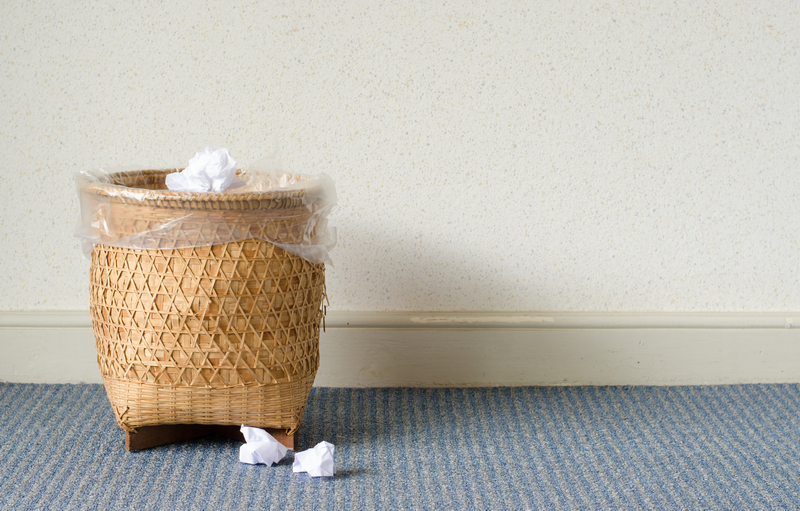The Best Methods for Disposing of Unwanted Pots and Pans
Have you ever opened your kitchen cabinet only to be greeted by towers of unused or damaged cookware? Over time, many of us accumulate old pots and pans that are scratched, warped, or simply out of favor with our current cooking style. Instead of letting these items gather dust, it's important--and environmentally responsible--to consider the best methods for disposing of unwanted pots and pans. This comprehensive guide will walk you through multiple options, such as recycling, donation, upcycling, and safe disposal, so you can make the most ethical and effective decision for your unwanted cookware.
Why Proper Pots and Pans Disposal Matters
Disposing of old pots and pans isn't as simple as tossing them in the trash. Most cookware is made from a combination of metals and coatings, such as non-stick finishes and plastic handles, which can be harmful to the environment if not handled correctly. Recycling and repurposing play a crucial role in reducing landfill waste, conserving resources, and supporting a cleaner world.
The Environmental Impact of Improper Cookware Disposal
- Landfill Overload: Pots and pans take years--even centuries--to break down in landfills, taking up valuable space.
- Release of Chemicals: Non-stick cookware, when incinerated or broken down, may release harmful chemicals like perfluorooctanoic acid (PFOA) into soil and water.
- Loss of Reusable Metals: Pans are usually made of metals (steel, aluminum, copper) that can be recycled and reused, but only if disposed of properly.
Now, let's explore the main disposal methods to ensure you make an eco-friendly and informed choice.

Step One: Evaluate the Condition of Your Pots and Pans
Before deciding on a disposal method, examine whether your cookware is truly at the end of its life. Sometimes, minor wear can be remedied with a good cleaning or by replacing a broken handle. Ask yourself:
- Is the pot or pan warped, cracked, or severely corroded?
- Are the non-stick coatings scratched or peeling?
- Is it still safe to use?
- Would someone else benefit from using it?
Answering these questions ensures unwanted pots and pans go to the most suitable destination.
The Top Methods for Disposing of Unwanted Pots and Pans
There are various ways to get rid of old pots and pans responsibly. Below are the most effective and sustainable solutions.
1. Donate Gently Used Cookware
If your old cookware is still usable--meaning it isn't warped or badly scratched--it may serve someone else well. Consider the following donation options to keep your unused cookware in circulation:
- Charity Thrift Stores: Places like Goodwill, Salvation Army, or local charity shops accept clean, gently used kitchenware.
- Homeless Shelters and Community Kitchens: Large pots and pans are particularly appreciated at organizations serving hot meals.
- School Programs and Community Centers: Many schools have culinary programs in need of inexpensive equipment.
- Online Giveaway Sites: Platforms like Freecycle, Facebook Marketplace (free section), or Craigslist let you pass on items directly.
Ensure that pots and pans are thoroughly cleaned and sanitized before donating. Donation helps the environment and provides affordable cookware to others in need.
2. Recycling Old Pots and Pans
When your cookware is no longer functional, recycling is the most environmentally responsible disposal method. Most pots and pans are made from metals like stainless steel, cast iron, aluminum, or copper--all of which are highly recyclable.
How to Recycle Different Types of Cookware
- Metal Pots and Pans: Remove any non-metal parts (plastic handles, glass lids) if possible. Drop them off at your local metal recycling or scrap yard. Some community recycling centers also accept metal pots and pans.
- Non-stick, Ceramic-Coated, or Teflon Pans: Many recycling centers do NOT accept pans with non-stick coatings due to chemical contamination. Check with local authorities before attempting to recycle these.
- Cast Iron: Cast iron is highly sought after by scrap metal dealers and can fetch a small fee. Alternatively, consider restoring it if it's not cracked.
- Copper: Copper pans without plastic or wood handles can be recycled. Separate different metals if possible for higher value at scrap yards.
Always consult your city or county's recycling guidelines before dropping cookware in your recycling bin, as rules vary widely.
3. Upcycle and Repurpose for DIY Projects
Upcycling is a creative and eco-friendly way to dispose of old pots and pans, especially those with cosmetic defects. Here are some innovative ideas:
- Planters: Drill drainage holes in pots and pans to turn them into whimsical garden planters or herb gardens.
- Bird Baths or Feeders: Large pans make great shallow bird baths or stylish feeders.
- Organizers: Use deep pans or Dutch ovens to organize tools, magazines, or craft supplies.
- Decorative Art: Paint or embellish old pots and hang them as wall art or wind chimes.
- Candle Holders: Small metal pans can be reused as a base for DIY candles.
Upcycling not only reduces waste but also adds a touch of personal flair to your home or garden.
4. Return to Manufacturer Recycling Programs
Some cookware brands offer take-back or recycling programs for their old pots and pans. Notable brands and retailers that may accept unwanted cookware include:
- GreenPan: Offers a Cookware Recycling Program in the USA--customers can mail back used GreenPan products for responsible recycling.
- Calphalon: Occasionally runs a trade-in and recycle event, offering discounts on new items.
- Local Kitchenware Stores: Some stores partner with recycling programs or hold annual drives.
Check the brand's website or customer service for current policies. This method ensures your old pans are recycled through official channels.
5. Curbside Bulk Waste Pickup
If recycling is not available or practical for you, many municipalities allow for bulk waste pickup of large household metal items. Be sure to:
- Contact Local Sanitation Department: Ask if pots and pans are accepted in bulk or metal-only pickups.
- Prepare Items Properly: Remove non-metal components and group similar materials together if required.
This option ensures your old cookware is handled by waste professionals, though it is not always the most environmentally friendly unless your city separates and recycles metals.
6. Landfill Disposal (The Least Desirable Option)
As a last resort, completely unusable pots and pans may be thrown away. However, this is rarely recommended due to the environmental impact. If you must dispose via trash:
- Try to remove and recycle any metal parts possible.
- Ensure all food and residue is rinsed off.
- Use your local landfill or waste facility--some may have special sorting for metals.
Direct landfill disposal should only be used if all other avenues have been exhausted.
Frequently Asked Questions: Disposing of Old Pots and Pans
Can pots and pans go in the recycling bin?
Rarely. Do not place old cookware directly in most residential recycling bins, since household recycling is usually for items like cans, bottles, and plastic containers, not bulky metal items. Use a scrap yard or metal recycling drop-off instead.
What about cookware with plastic handles or glass lids?
Remove any non-metal components if recycling. Glass is typically not accepted with metals, but some centers may accept certain types of glass lids separately. Plastics usually need to go in the trash unless otherwise instructed by your recycler.
How do I know if my non-stick pan is safe to donate?
Do not donate non-stick pans if the coating is peeling, scratched, or damaged, as this poses potential health risks. Only donate non-stick cookware that's clean and undamaged.
Are there any upcycling ideas for broken pots?
Yes! Repurpose as garden decor, use pots as storage bins, or turn broken ceramic cookware into mosaic tiles for crafts.

Summary: Choosing the Best Way to Get Rid of Unwanted Cookware
Your old pots and pans don't have to be a burden or an environmental hazard. By following the methods outlined above, you can make your cookware disposal process easy, responsible, and possibly even rewarding. Remember:
- Donate gently used items to extend their life and help others.
- Recycle metal cookware whenever possible to conserve resources.
- Upcycle for fun DIY projects and minimize your carbon footprint.
- Use manufacturer programs for hassle-free, sustainable disposal.
- Consider municipal bulk pickup only if other options are unavailable.
- Landfill disposal should be the absolute last choice.
Disposing of old pots and pans can be straightforward when you know your options. Whether you choose to recycle, donate, repurpose, or return your items through a retailer program, you are making a positive impact on the environment and potentially helping others. So next time you declutter your kitchen, use these smart strategies for a greener, cleaner home.
Conclusion
By choosing eco-friendly methods for disposing of unwanted pots and pans, you help preserve natural resources, support your community, and keep hazardous materials out of landfills. Take the simple steps presented in this guide to clear your cabinets and reduce waste the responsible way. A cleaner, greener kitchen starts with smart disposal!